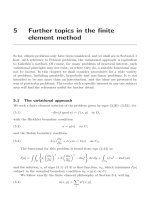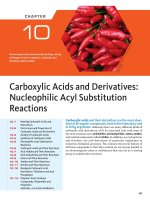Ebook Fundamentals of organic chemistry (7th edition) Part 2
Bạn đang xem bản rút gọn của tài liệu. Xem và tải ngay bản đầy đủ của tài liệu tại đây (37.77 MB, 335 trang )
CHAPTER
9. U
sed
200
Ima
Shu ge co
tte pyr
rsto igh
ck. t Ar
com iy,
The burning sensation produced by touching or eating
chili peppers is due to capsaicin, a carboxylic acid
derivative called an amide.
und
er l
ice
nse
fro
m
10
Carboxylic Acids and Derivatives:
Nucleophilic Acyl Substitution
Reactions
10.1
10.2
10.3
10.4
10.5
10.6
10.7
10.8
10.9
10.10
10.11
10.12
10.13
Naming Carboxylic Acids and
Derivatives
Occurrence and Properties of
Carboxylic Acids and Derivatives
Acidity of Carboxylic Acids
Synthesis of Carboxylic Acids
Nucleophilic Acyl Substitution
Reactions
Carboxylic Acids and Their Reactions
Acid Halides and Their Reactions
Acid Anhydrides and Their Reactions
Esters and Their Reactions
Amides and Their Reactions
Nitriles and Their Reactions
Biological Carboxylic Acid
Derivatives: Thioesters and Acyl
Phosphates
Polymers from Carbonyl
Compounds: Polyamides and
Polyesters
Interlude—-Lactam Antibiotics
Carboxylic acids and their derivatives are the most abundant of all organic compounds, both in the laboratory and
in living organisms. Although there are many different kinds of
carboxylic acid derivatives, we’ll be concerned only with some of
the most common ones: acid halides, acid anhydrides, esters, amides,
and related compounds called nitriles. In addition, acyl phosphates
and thioesters are acid derivatives of particular importance in
numerous biological processes. The common structural feature of
all these compounds is that they contain an acyl group bonded to
an electronegative atom or substituent that can act as a leaving
group in substitution reactions.
325
326
C H A P T E R 10 |
Carboxylic Acids and Derivatives: Nucleophilic Acyl Substitution Reactions
O
Online homework for this chapter can be
assigned in OWL, an online homework
assessment tool.
O
C
C
OH
R
Carboxylic acid
Acid anhydride
Amide
P
C
SRЈ
R
Thioester
Ester
O
O
C
R
NH2
ORЈ
R
RЈ
O
O
C
C
C
R
Acid halide
(X = Cl, Br)
O
R
C
X
R
O
O
O
O
O–
R
O–
Acyl phosphate
C
N
Nitrile
WHY THIS CHAPTER?
Because carboxylic acids and their derivatives are involved in so many industrial processes and most biological pathways, an understanding of their properties and behavior is fundamental to understanding organic and biological
chemistry. In this chapter, we’ll first discuss carboxylic acids themselves and
will then explore in detail the most common reaction of carboxylic acid derivatives—the nucleophilic acyl substitution reaction.
10.1 Naming Carboxylic Acids and Derivatives
Carboxylic Acids: RCO2H
Simple open-chain carboxylic acids are named by replacing the terminal -e of
the corresponding alkane name with -oic acid. The ᎐ CO2H carbon is numbered C1.
O
CH3
O
O
CH2CH3
CH3
O
CH3CH2COH
CH3CHCH2CH2COH
HOCCH2CHCH2CH2CHCH2COH
Propanoic acid
4-Methylpentanoic acid
3-Ethyl-6-methyloctanedioic acid
5
4
3
2
1
12
3
4
5
6
7
8
Compounds that have a ᎐ CO2H group (a carboxyl group) bonded to a ring
are named using the suffix -carboxylic acid. The carboxyl carbon is attached
to C1 on the ring and is not itself numbered.
6
5
HO
1
1
CO2H
5
2
2
4
H
CO2H
H
3
trans-4-Hydroxycyclohexanecarboxylic acid
4
3
Cyclopent-1-enecarboxylic acid
Because many carboxylic acids were among the first organic compounds to
be isolated and purified, a large number of acids have common names (Table
10.1). We’ll use systematic names in this book, with the exception of formic
10 .1
| Naming Carboxylic Acids and Derivatives
327
(methanoic) acid, HCO2H, and acetic (ethanoic) acid, CH3CO2H, whose names
are so well known that it makes little sense to refer to them in any other way.
Also listed in Table 10.1 are the names for acyl groups (R ᎐ CϭO) derived from
the parent acids by removing ᎐ OH. Except for the eight acyl groups at the top
of Table 10.1, whose common names have a -yl ending, all others are named
systematically with an -oyl ending.
Table 10.1
Some Common Names of Carboxylic Acids and Acyl Groups
Structure
Name
Acyl group
HCO2H
CH3CO2H
CH3CH2CO2H
CH3CH2CH2CO2H
HO2CCO2H
HO2CCH2CO2H
HO2CCH2CH2CO2H
HO2CCH2CH2CH2CO2H
HO2CCH2CH2CH2CH2CO2H
H2CPCHCO2H
HO2CCHPCHCO2H
Formic
Acetic
Propionic
Butyric
Oxalic
Malonic
Succinic
Glutaric
Adipic
Acrylic
Maleic (cis)
Fumaric (trans)
Benzoic
Formyl
Acetyl
Propionyl
Butyryl
Oxalyl
Malonyl
Succinyl
Glutaryl
Adipoyl
Acryloyl
Maleoyl
Fumaroyl
Benzoyl
CO2H
Acid Halides: RCOX
Acid halides are named by identifying first the acyl group, as in Table 10.1, and
then the halide. Those cyclic carboxylic acids that take a -carboxylic acid ending
use -carbonyl for the name ending of the corresponding acyl group. For example:
O
O
C
O
C
Br
Cl
C
H3C
Cl
Acetyl chloride
(from acetic acid)
Benzoyl bromide
(from benzoic acid)
Cyclohexanecarbonyl chloride
(from cyclohexanecarboxylic acid)
Acid Anhydrides: RCO2COR′
Symmetrical anhydrides from simple carboxylic acids and cyclic anhydrides
from dicarboxylic acids are named by replacing the word acid with anhydride.
O
O
H3C
O
O
C
C
O
C
C
O
CH3
Acetic anhydride
Benzoic anhydride
O
O
O
Succinic anhydride
328
C H A P T E R 10 |
Carboxylic Acids and Derivatives: Nucleophilic Acyl Substitution Reactions
Unsymmetrical anhydrides—those prepared from two different carboxylic
acids—are named by citing the two acids alphabetically and then adding
anhydride.
O
O
C
C
H3C
Acetic benzoic anhydride
O
Amides: RCONH2
Amides with an unsubstituted ᎐ NH2 group are named by replacing the -oic
acid or -ic acid ending with -amide, or by replacing the -carboxylic acid ending
with -carboxamide.
O
H3C
O
O
C
C
NH2
CH3CH2CH2CH2CH2
Acetamide
C
NH2
NH2
Hexanamide
Cyclopentanecarboxamide
If the nitrogen atom is substituted, the amide is named by first identifying
the substituent groups and then the parent amide. The substituents are preceded by the letter N to identify them as being directly attached to nitrogen.
O
O
C
N
CH3CH2
C
CH3
N
CH2CH3
CH2CH3
H
N,N-Diethylcyclohexanecarboxamide
N-Methylpropanamide
Esters: RCO2R′
Esters are named by first giving the name of the alkyl group attached to oxygen and then identifying the carboxylic acid, with -ic acid replaced by -ate.
O
O
C
C
OCH2CH3
C
C
CH3O
C
H3C
O H3C
O
H
OCH3
C
O
CH3
H
Dimethyl malonate
Ethyl acetate
CH3
tert-Butyl cyclohexanecarboxylate
Nitriles: ROCqN
Compounds containing the ᎐ CϵN functional group are called nitriles. Simple
acyclic nitriles are named by adding -nitrile as a suffix to the alkane name,
with the nitrile carbon numbered C1.
CH3
CH3CHCH2CH2CN
5
4
3
2
1
4-Methylpentanenitrile
10 .1
| Naming Carboxylic Acids and Derivatives
329
More complex nitriles are named as derivatives of carboxylic acids by
replacing the -ic acid or -oic acid ending with -onitrile, or by replacing the
-carboxylic acid ending with -carbonitrile. In this system, the nitrile carbon
atom is attached to C1 but is not itself numbered.
C
CH3C
6
N
1
5
N
CH3
4
2
3
Acetonitrile
(from acetic acid)
Problem 10.1
Benzonitrile
(from benzoic acid)
2,2-Dimethylcyclohexanecarbonitrile
(from 2,2-dimethylcyclohexanecarboxylic acid)
(d)
H
(e)
C
O
C
H
CO2H
(c)
O
CH3CHCH2CH2COH
H
H3C
Br
(b)
O
CH3
CH3CHCH2COH
CH3CH2CHCH2CH2CH3
H
HO2C
CO2H
CH2CH2COH
Draw structures corresponding to the following names:
(a) 2,3-Dimethylhexanoic acid
(c) o-Hydroxybenzoic acid
Problem 10.3
CH3
Give IUPAC names for the following carboxylic acids:
(a)
Problem 10.2
CN
(b) 4-Methylpentanoic acid
(d) trans-Cyclobutane-1,2-dicarboxylic acid
Give IUPAC names for the following acyl derivatives:
(a)
O
(b)
O
CH3
(c)
CH2CNH2
CH3CHCH2CH2CCl
O
CH3CHCOCHCH3
CH3 CH3
(d)
(e)
O
C
C
O
OCHCH3
O
CH3
2
(g)
O
H2C
Problem 10.4
CHCH2CH2CNHCH3
(h)
CH3
(f)
O
C
CHCH3
O
CH3
CH3CH2CHCN
Draw structures corresponding to the following names:
(a) 2,2-Dimethylpropanoyl chloride
(c) 5,5-Dimethylhexanenitrile
(e) trans-2-Methylcyclohexanecarboxamide
(g) cis-3-Methylcyclohexanecarbonyl bromide
(b) N-Methylbenzamide
(d) tert-Butyl butanoate
( f ) p-Methylbenzoic
anhydride
(h) p-Bromobenzonitrile
330
C H A P T E R 10 |
Carboxylic Acids and Derivatives: Nucleophilic Acyl Substitution Reactions
10.2 Occurrence and Properties
of Carboxylic Acids and Derivatives
Carboxylic acids are everywhere in nature. Acetic acid, CH3CO2H, for
instance, is the principal organic component of vinegar; butanoic acid,
CH3CH2CH2CO2H, is responsible for the rancid odor of sour butter; and hexanoic acid (caproic acid), CH3(CH2)4CO2H, is responsible for the aroma of goats
(Latin caper, meaning “goat”) and dirty socks.
Approximately 5 million tons of acetic acid are produced each year worldwide
for a variety of purposes, including preparation of the vinyl acetate polymer used
in paints and adhesives. About 20% of the acetic acid synthesized industrially is
obtained by oxidation of acetaldehyde. Much of the remaining 80% is prepared
by the rhodium-catalyzed reaction of methanol with carbon monoxide.
O
CH3OH
+
Rh catalyst
CO
C
H3C
OH
Like alcohols, carboxylic acids form strong intermolecular hydrogen bonds.
Most carboxylic acids, in fact, exist as dimers held together by two hydrogen
bonds. This strong hydrogen bonding has a noticeable effect on boiling points,
making carboxylic acids boil at substantially higher temperatures than
alkanes or alcohols of similar molecular weight. Acetic acid, for instance has
a boiling point of 117.9 °C, versus 78.3 °C for ethanol.
O
H3C
H
O
C
C
O
H
CH3
O
Acetic acid dimer
Esters, like carboxylic acids, are widespread in nature. Many simple esters
are pleasant-smelling liquids that are responsible for the fragrant odors of
fruits and flowers. For example, methyl butanoate is found in pineapple oil,
and isopentyl acetate is a constituent of banana oil. The ester linkage is also
present in animal fats and in many other biologically important molecules.
O
O
O
CH2OCR
O
CH3
CH3CH2CH2COCH3
CH3COCH2CH2CHCH3
Methyl butanoate
(from pineapples)
Isopentyl acetate
(from bananas)
CHOCR
O
CH2OCR
A fat
(R = C11–17 chains)
10 . 3
| Acidity of Carboxylic Acids
331
The chemical industry uses esters for a variety of purposes: ethyl acetate is
a commonly used solvent, and dialkyl phthalates are used as plasticizers to
keep polymers from becoming brittle. You might be aware that there is current
concern about possible toxicity of phthalates at high concentrations, although a
recent assessment by the U.S. Food and Drug Administration found the risk to
be minimal for most people, with the possible exception of male infants.
O
C
OCH2CH2CH2CH3
Dibutyl phthalate
(a plasticizer)
OCH2CH2CH2CH3
C
O
Amides, like acids and esters, are abundant in living organisms—proteins,
nucleic acids, and many pharmaceuticals have amide functional groups. The
reason for this abundance of amides is that they are the least reactive of the
common acid derivatives and are thus stable to the temperatures and aqueous conditions found in living organisms.
H
H
H
O
R
H
H
N
N
O
N
H
R
H
O
H
H
N
O
S
CH3
N
O
R
H
A protein segment
CH3
CO2–
Benzylpenicillin
(penicillin G)
O
N
O
–OPOCH
O–
2
O
OH
N
H
O
OH
Uridine 5Ј-phosphate
(a ribonucleotide)
Acid chlorides and anhydrides are frequently used in chemical laboratories
but are not found in nature because of their high reactivity.
10.3 Acidity of Carboxylic Acids
The most obvious property of carboxylic acids is implied by their name: carboxylic acids are acidic. Acetic acid, for example, has Ka ϭ 1.75 ϫ 10؊5
(pKa ϭ 4.76). In practical terms, a Ka value near 10؊5 means that only about
332
C H A P T E R 10 |
Carboxylic Acids and Derivatives: Nucleophilic Acyl Substitution Reactions
1% of the molecules in a 0.1 M aqueous solution are dissociated. Because of
their acidity, carboxylic acids react with bases such as NaOH to give watersoluble metal carboxylates, RCO2؊ Na؉.
O
O
+
C
R
NaOH
H2O
C
R
OH
A carboxylic acid
(water-insoluble)
O– Na+
+
H2O
A carboxylic acid salt
(water-soluble)
As indicated by the list of Ka values in Table 10.2, there is a considerable
range in the strengths of various carboxylic acids. For most, Ka is in the range
10؊4 to 10؊5, but some, such as trifluoroacetic acid (Ka ϭ 0.59) are much stronger. The electron-withdrawing fluorine substituents stabilize the carboxylate
ion by sharing the negative charge and thus favor dissociation of the acid.
Table 10.2
Acid Strengths of Some Carboxylic Acids
Structure
Ka
pKa
CF3CO2H
0.59
0.23
HCO2H
1.77 ϫ 10؊4
3.75
HOCH2CO2H
1.5 ϫ 10؊4
3.84
C6H5CO2H
6.46 ϫ 10؊5
4.19
H2CPCHCO2H
5.6 ϫ 10؊5
4.25
CH3CO2H
1.75 ϫ 10؊5
4.76
CH3CH2CO2H
1.34 ϫ 10؊5
4.87
CH3CH2OH (ethanol)
(1.00 ϫ 10؊16)
(16.00)
Stronger
acid
Weaker
acid
Although much weaker than mineral acids, carboxylic acids are nevertheless much stronger acids than alcohols and phenols. The Ka of ethanol, for
example, is approximately 10؊16, making ethanol a weaker acid than acetic
acid by a factor of 1011.
OH
O
CH3CH2OH
pKa = 16
pKa = 9.89
Acidity
CH3COH
HCl
pKa = 4.76
pKa = –7
10 . 3
| Acidity of Carboxylic Acids
333
Why are carboxylic acids so much more acidic than alcohols even though
both contain ᎐ OH groups? To answer this question, compare the relative
stabilities of carboxylate anions versus alkoxide anions (Figure 10.1). In an
alkoxide ion, the negative charge is localized on one oxygen atom, but in
a carboxylate ion, the negative charge is spread out over both oxygen
atoms because a carboxylate anion is a resonance hybrid of two equivalent
structures (Section 4.10). Because a carboxylate ion is more stable than
an alkoxide ion, it is lower in energy and is present to a greater extent at
equilibrium.
Figure 10.1 An alkoxide ion has
its charge localized on one oxygen
atom and is less stable, while a
carboxylate ion has the charge
spread equally over both oxygens
and is therefore more stable.
H
H
H
H
H
H2O
O
C
H
H
C
H3O؉
+
H
C
H
H
Ethanol
O
C
–
H
Ethoxide ion
(localized charge)
O
C
H
O
C
H
O
C
H
H
H
H2O
O
C
H3O؉
؊
H
+
H
O
؊
Acetic acid
C
H
O
C
H
H
Acetate ion
(delocalized charge)
Worked Example 10.1
Predicting Acid Strength
Which would you expect to be the stronger acid, benzoic acid or p-nitrobenzoic
acid?
Solution
The more stabilized the carboxylate anion, the stronger the acid. We know from
its effect on aromatic substitution (Section 5.7) that a nitro group is electronwithdrawing and can stabilize a negative charge. Thus, a p-nitrobenzoate ion is
more stable than a benzoate ion, and p-nitrobenzoic acid is stronger than benzoic acid.
O
C
–O
NO2
Nitro group withdraws electrons
from ring and stabilizes negative
charge.
334
C H A P T E R 10 |
Carboxylic Acids and Derivatives: Nucleophilic Acyl Substitution Reactions
Problem 10.5
Draw structures for the products of the following reactions:
(a)
CO2H
CH3
(b)
NaOCH3
?
KOH
CH3CCO2H
?
CH3
Problem 10.6
Rank the following compounds in order of increasing acidity:
(a) Sulfuric acid, methanol, phenol, p-nitrophenol, acetic acid
(b) Benzoic acid, ethanol, p-cyanobenzoic acid
Problem 10.7
Which would you expect to be a stronger acid, the lactic acid found in tired
muscles or acetic acid? Explain.
HO O
CH3CHCOH
Lactic acid
10.4 Synthesis of Carboxylic Acids
Let’s review briefly several methods for preparing carboxylic acids that we’ve
seen in past chapters.
• A substituted alkylbenzene can be oxidized with KMnO4 to give a
substituted benzoic acid (Section 5.8).
O
O2N
CH3
KMnO4
H2O, 95 °C
p-Nitrotoluene
O2N
COH
p-Nitrobenzoic acid (88%)
• Primary alcohols and aldehydes can be oxidized with aqueous CrO3 or
Na2Cr2O7 to give carboxylic acids (Sections 8.4 and 9.4).
CH3
CH3
CH3CHCH2CH2CH2OH
CrO3
H3O+
4-Methylpentan-1-ol
O
CH3CHCH2CH2COH
4-Methylpentanoic acid
O
CH3CH2CH2CH2CH2CH
Hexanal
O
CrO3
H3O+
CH3CH2CH2CH2CH2COH
Hexanoic acid
In addition to the preceding two methods, there are numerous other ways
to prepare carboxylic acids. For instance, carboxylic acids can be prepared
from nitriles, ROCqN, by a hydrolysis reaction with hot aqueous acid or base.
Since nitriles themselves are usually prepared by an SN2 reaction between
an alkyl halide and cyanide ion, CN؊, the two-step sequence of cyanide ion
| Nucleophilic Acyl Substitution Reactions
10 . 5
335
displacement followed by nitrile hydrolysis is a good method for converting an
alkyl halide into a carboxylic acid: RBr n RCqN n RCO2H. As with all
SN2 reactions, the method works best with primary alkyl halides, although
secondary alkyl halides can sometimes be used (Section 7.5).
An example of nitrile hydrolysis occurs in the commercial synthesis of the
antiarthritis drug fenoprofen, a nonsteroidal anti-inflammatory agent (see
Chapter 5 Interlude) marketed under the name Nalfon.
O
Br H
H
C
O
CH3
C
OH
C
O
CH3
1. NaCN
2. NaOH, H2O
3. H3O+
Fenoprofen
(an antiarthritis agent)
Problem 10.8
Show the steps in the conversion of iodomethane to acetic acid by the nitrile
hydrolysis route. Would a similar route work for the conversion of iodobenzene
to benzoic acid? Explain.
10.5 Nucleophilic Acyl Substitution Reactions
We saw in Chapter 9 that the addition of a nucleophile to the polar CϭO bond
is a general feature of aldehyde and ketone chemistry. Carboxylic acids and
their derivatives also react with nucleophiles, but the ultimate product is different from that of the aldehyde/ketone reaction. Instead of undergoing
protonation to yield an alcohol, the initially formed alkoxide intermediate
expels one of the substituents originally bonded to the carbonyl carbon,
leading to the formation of a new carbonyl compound by a nucleophilic acyl
substitution reaction (Figure 10.2).
Figure 10.2 The general mechanisms
of nucleophilic addition and nucleophilic acyl substitution reactions. Both
reactions begin with the addition of
a nucleophile to a polar C؍O bond to
give a tetrahedral, alkoxide ion intermediate. The intermediate formed from
an aldehyde or ketone is protonated to
give an alcohol, but the intermediate
formed from a carboxylic acid derivative expels a leaving group to give a
new carbonyl compound.
Aldehyde or ketone: nucleophilic addition
Nu–
O
O
C
R
–
OH
H3O+
C
R
RЈ
C
Nu
RЈ
R
Nu
RЈ
Alkoxide ion
intermediate
Carboxylic acid derivative: nucleophilic acyl substitution
Nu–
O
O
C
R
–
O
C
Y
R
Y
+
C
Nu
Alkoxide ion
intermediate
R
Nu
Y–
336
C H A P T E R 10 |
Carboxylic Acids and Derivatives: Nucleophilic Acyl Substitution Reactions
The different behavior toward nucleophiles of aldehydes/ketones and carboxylic acid derivatives is a consequence of structure. Carboxylic acid derivatives have an acyl carbon bonded to a group ᎐Y that can leave as a stable
anion. As soon as addition of a nucleophile occurs, the group leaves and a new
carbonyl compound forms. Aldehydes and ketones have no such leaving group,
however, and therefore don’t undergo substitution.
NOT a leaving group
A leaving group
O
O
C
R
O
C
R
Y
C
R
H
An aldehyde
A carboxylic acid
derivative
RЈ
A ketone
Both the initial addition step and the subsequent elimination step can
affect the overall rate of a nucleophilic acyl substitution reaction, but the
addition step is generally the rate-limiting one. Thus, any factor that makes
the carbonyl group more reactive toward nucleophiles favors the substitution
process.
As a general rule, the more electron-poor the CϭO carbon, the more readily
the compound reacts with nucleophiles. Thus, acid chlorides are the most
reactive compounds because the electronegative chlorine atom strongly withdraws electrons from the carbonyl carbon, whereas amides are the least reactive compounds. Although the differences are subtle, electrostatic potential
maps indicate the relative reactivities of various carboxylic acid derivatives
by the relative blueness on the CϭO carbons. Note that thioesters, RCOSR′,
which are commonly found in biological molecules, have a reactivity intermediate between that of esters and acid anhydrides. Thioesters are thus stable enough to exist in living organisms but are reactive enough to be useful.
O
O
<
C
R
NH2
Amide
O
<
C
R
OR'
Ester
O
<
C
R
SR'
Thioester
O
C
R
O
<
C
O
R
Acid anhydride
C
R
Cl
Acid chloride
Reactivity
A consequence of these reactivity differences is that it’s usually possible
to convert a more reactive acid derivative into a less reactive one. Acid chlorides, for example, can be converted into esters and amides, but amides and
10 . 5
| Nucleophilic Acyl Substitution Reactions
337
esters can’t be converted into acid chlorides. Remembering the reactivity
order is therefore a useful way to keep track of a large number of reactions
(Figure 10.3).
Figure 10.3 Interconversions of car-
O
More
reactive
boxylic acid derivatives. More reactive
compounds can be converted into less
reactive ones, but not vice versa.
C
R
Cl
Acid chloride
O
O
C
C
R
O
R
Reactivity
Acid anhydride
O
C
R
SRЈ
Thioester
O
C
R
ORЈ
Ester
O
C
R
Less
reactive
NH2
Amide
In studying the chemistry of carboxylic acids and derivatives in the next
few sections, we’ll be concerned largely with the reactions of just a few
nucleophiles and will see that the same kinds of reactions keep occurring
(Figure 10.4).
•
•
•
•
•
Hydrolysis: Reaction with water to yield a carboxylic acid
Alcoholysis: Reaction with an alcohol to yield an ester
Aminolysis: Reaction with ammonia or an amine to yield an amide
Reduction: Reaction with a hydride reducing agent to yield an alcohol
Grignard reaction: Reaction with an organomagnesium reagent to
yield an alcohol
Figure 10.4 Some general reactions
of carboxylic acid derivatives.
O
C
R
ORЈ
Alcoholysis
O
C
C
R
NH2
R
NH3
[H–]
H2O
C
OH
Hydrolysis
R
OH
[H–]
O
RЈMgX
C
R
H
C
H
O
O
H
Reduction
Aminolysis
RЈOH
R
O
Y
Acid
derivative
C
R
RЈ RЈ
RЈMgX
RЈ
C
R
Grignard reaction
OH
338
C H A P T E R 10 |
Carboxylic Acids and Derivatives: Nucleophilic Acyl Substitution Reactions
Worked Example 10.2
Predicting the Product of a Nucleophilic Acyl Substitution Reaction
Predict the product of the following nucleophilic acyl substitution reaction of
benzoyl chloride with propan-2-ol:
O
OH
C
Cl
CH3CHCH3
?
Benzoyl chloride
Strategy
A nucleophilic acyl substitution reaction involves the substitution of a nucleophile for a leaving group in a carboxylic acid derivative. Identify the leaving
group (Cl؊ in the case of an acid chloride) and the nucleophile (an alcohol in
this case), and replace one by the other. The product is the ester isopropyl
benzoate.
Solution
Leaving group
Nucleophile
O
O
OH
C
Cl
C
CH3CHCH3
C
O
CH3
Which compound in each of the following sets is more reactive in nucleophilic
acyl substitution reactions?
(a)
(b)
(c)
(d)
Problem 10.10
CH3
Isopropyl benzoate
Benzoyl chloride
Problem 10.9
H
CH3COCl or CH3CO2CH3
(CH3)2CHCONH2 or CH3CH2CO2CH3
CH3CO2CH3 or CH3CO2COCH3
CH3CO2CH3 or CH3CHO
Predict the products of the following nucleophilic acyl substitution reactions:
(a)
NaOH
C
H3C
(c)
H3C
O
(b)
O
OCH3
O
O
C
C
O
H2O
?
H3C
Na+ –OCH3
CH3
CH3OH
NH3
C
?
Cl
O
(d)
?
CH3NH2
C
H3C
SCH3
?
10 . 6
| Carboxylic Acids and Their Reactions
339
10.6 Carboxylic Acids and Their Reactions
The direct nucleophilic acyl substitution of a carboxylic acid is difficult
because ᎐ OH is a poor leaving group (Section 7.5). Thus, it’s usually necessary to enhance the reactivity of the acid, either by using a strong acid catalyst to protonate the carboxyl and make it a better acceptor or by converting
the ᎐ OH into a better leaving group. Under the right conditions, however,
acid chlorides, anhydrides, esters, and amides can all be prepared from carboxylic acids.
Conversion of Acids into Acid Chlorides (RCO2H n RCOCl)
Carboxylic acids are converted into acid chlorides by treatment with thionyl
chloride, SOCl2. The reaction occurs by a nucleophilic acyl substitution
pathway in which the carboxylic acid is first converted into an acyl chlorosulfite intermediate, thereby replacing the ᎐ OH of the acid with a much
better leaving group. The chlorosulfite then reacts with a nucleophilic chloride ion.
O
O
SOCl2
C
R
O
C
OH
Cl
Carboxylic
acid
–
O
C
S
O
R
O
– Cl
R
Cl
O
+
C
S
O
Cl
R
A chlorosulfite
Cl
SO2
Acid chloride
Conversion of Acids into Esters (RCO2H n RCO2R′)
Perhaps the most useful reaction of carboxylic acids is their conversion into
esters by reaction with an alcohol—the substitution of ᎐ OH by ᎐ OR. Called
the Fischer esterification reaction, the simplest method involves heating the
carboxylic acid with an acid catalyst in an alcohol solvent.
O
O
C
OH
Benzoic acid
+
HCl
catalyst
CH3CH2OH
C
OCH2CH3
+
H2O
Ethyl benzoate (91%)
As shown in Figure 10.5, the acid catalyst first protonates an oxygen atom
of the ᎐ CO2H group, which gives the carboxylic acid a positive charge and
makes it more reactive toward nucleophiles. An alcohol molecule then adds to
the protonated carboxylic acid, and subsequent loss of water yields the ester
product.
340
C H A P T E R 10 |
Carboxylic Acids and Derivatives: Nucleophilic Acyl Substitution Reactions
MECHANISM
Figure 10.5 Mechanism of the
Fischer esterification reaction of a
carboxylic acid to yield an ester. The
reaction is an acid-catalyzed nucleophilic acyl substitution.
H
Cl
O
C
R
OH
1 Protonation of the carbonyl oxygen
activates the carboxylic acid . . .
1
H
+
O
RЈ
C
O
R
OH
H
2 . . . toward nucleophilic attack by alcohol,
yielding a tetrahedral intermediate.
2
OH
R
HO
C
RЈ
O+
H
3 Transfer of a proton from one oxygen
atom to another yields a second
tetrahedral intermediate and converts
the OH group into a good leaving group.
3
H
O
R
H +O
C
OH2
ORЈ
H
4 Loss of a proton and expulsion of H2O
regenerates the acid catalyst and gives
the ester product.
O
+
C
R
ORЈ
H3O+
© John McMurry
4
All steps in the Fischer esterification reaction are reversible, and the position of the equilibrium can be driven either forward or backward depending
on the reaction conditions. Ester formation is favored when alcohol is used as
the solvent, but carboxylic acid is favored when the solvent is water.
Conversion of Acids into Amides (RCO2H n RCONH2)
Amides are carboxylic acid derivatives in which the acid ᎐ OH group has been
replaced by a nitrogen substituent, ᎐ NH2, ᎐ NHR, or ᎐ NR2. Amides are difficult to prepare directly from acids by substitution with an amine because
amines are bases, which convert acidic carboxyl groups into their unreactive
carboxylate anions. Thus, the ᎐ OH must be activated by making it a better,
10 . 6
| Carboxylic Acids and Their Reactions
341
nonacidic leaving group. In practice, amides are usually prepared by treating
the carboxylic acid with dicyclohexylcarbodiimide (DCC) to activate it, followed by addition of the amine. We’ll see in Section 15.7 that this DCC method
for preparing amides is particularly useful for the laboratory synthesis of
proteins from amino acids.
C6H11
H
+
C
R
N
O
O
OH
H
N
N
C
RЈNH2
C
C
R
O
C
NHRЈ
R
C6H11
Carboxylic
acid
+
C
N
C6H11
N
O
H
N
O
C6H11
Amide
DCC
Conversion of Acids into Alcohols (RCO2H n RCH2OH)
As we saw in Section 8.3, carboxylic acids are reduced by lithium aluminum
hydride (LiAlH4) to yield primary alcohols. The reaction occurs by initial substitution of the acid ᎐ OH group by ᎐ H to give an aldehyde intermediate that
is further reduced to the alcohol.
O
C
R
OH
(LiAlH4)
A carboxylic
acid
Worked Example 10.3
O
“H–”
“H–”
C
R
H
(LiAlH4)
An aldehyde
(not isolated)
H
H
C
R
H
H3O+
O–
An alkoxide
ion
H
C
R
OH
A 1° alcohol
Synthesizing an Ester from an Acid
How might you prepare the following ester using a Fischer esterification
reaction?
O
C
OCH2CH2CH3
Br
Strategy
Solution
Begin by identifying the two parts of the ester. The acyl part comes from the
carboxylic acid, and the ᎐ OR part comes from the alcohol. In this case, the target
molecule is propyl o-bromobenzoate, so it can be prepared by treating o-bromobenzoic acid with propan-1-ol.
O
O
C
C
OH
+
CH3CH2CH2OH
Br
o-Bromobenzoic acid
OCH2CH2CH3
HCl
catalyst
Br
Propan-1-ol
Propyl o-bromobenzoate
+
H2O
342
C H A P T E R 10 |
Carboxylic Acids and Derivatives: Nucleophilic Acyl Substitution Reactions
Problem 10.11
What products would you obtain by treating benzoic acid with the following
reagents?
(a) SOCl2
Problem 10.12
(b) CH3OH, HCl
(c) LiAlH4
(d) NaOH
Show how you might prepare the following esters using a Fischer esterification
reaction:
(a)
O
(b)
O
CH3COCH2CH2CH2CH3
O
(c)
CH3CH2CH2COCH3
CH3
C
OCHCH3
10.7 Acid Halides and Their Reactions
Acid chlorides are prepared from carboxylic acids by reaction with thionyl
chloride, SOCl2, as we saw in the previous section.
O
O
SOCl2
C
C
OH
R
Cl
R
Acid halides are among the most reactive of the various carboxylic acid
derivatives and can be converted into many other kinds of substances. The
halogen can be replaced by ᎐ OH to yield an acid, by ᎐ OR to yield an ester, or
by ᎐ NH2 to yield an amide. In addition, acid halides can be reduced by LiAlH4
to give primary alcohols or allowed to react with Grignard reagents to give
tertiary alcohols (Figure 10.6). Neither of these latter two processes is often
used, however, because the product alcohols can be made more conveniently
from esters. Although illustrated only for acid chlorides, similar reactions
take place with other acid halides.
Figure 10.6 Some nucleophilic acyl
O
substitution reactions of acid chlorides.
C
R
O
NH3
RЈOH
O
H
C
R
ORЈ
Ester
LiAlH4
OH
Carboxylic
acid
R
Aldehyde
OH
1° Alcohol
O
2 RЈMgX
C
R
H
C
H
O
H2O
C
R
O
Amide
C
R
NH2
Cl
Acid
chloride
RЈ RЈ
C
C
R
RЈ
Ketone
R
OH
3° Alcohol
10 .7
| Acid Halides and Their Reactions
343
Conversion of Acid Chlorides into Acids (RCOCl n RCO2H)
Acid chlorides react with water to yield carboxylic acids—the substitution
of ᎐ Cl by ᎐ OH. This hydrolysis reaction is a typical nucleophilic acyl substitution process and is initiated by attack of the nucleophile water on the acid
chloride carbonyl group. The initially formed tetrahedral intermediate undergoes loss of HCl to yield the product.
O
O
+
C
R
Cl
OH2
R
Cl
C
–
+ H
O
C
R
H
An acid
chloride
Base
O
+ H
O
R
H
O
C
OH
A carboxylic
acid
Conversion of Acid Chlorides into Esters (RCOCl n RCO2R′)
Acid chlorides react with alcohols to yield esters in a reaction analogous to
their reaction with water to yield acids.
O
O
C
OH
Cl
C
+
Cyclohexanol
Benzoyl
chloride
O
Pyridine
Cyclohexyl benzoate (97%)
Because HCl is generated as a by-product, the reaction is usually carried out
in the presence of an amine base such as pyridine (see Section 12.6), which
reacts with the HCl as it’s formed and prevents it from causing side reactions.
Conversion of Acid Chlorides into Amides (RCOCl n RCONH2)
Acid chlorides react rapidly with ammonia and with amines to give amides—
the substitution of ᎐ Cl by ᎐ NR2. Both monosubstituted and disubstituted
amines can be used. For example, 2-methylpropanamide is prepared by reaction of 2-methylpropanoyl chloride with ammonia. Note that one extra equivalent of ammonia is added to react with the HCl generated.
O
CH3CHCCl
O
+
2 NH3
CH3CHCNH2
CH3
2-Methylpropanoyl
chloride
Worked Example 10.4
+
+
NH4 Cl–
CH3
2-Methylpropanamide
(83%)
Synthesizing an Ester from an Acid Chloride
Show how you could prepare ethyl benzoate by reaction of an acid chloride with
an alcohol.
Strategy
As its name implies, ethyl benzoate can be made by reaction of ethyl alcohol
with the acid chloride of benzoic acid.
344
C H A P T E R 10 |
Carboxylic Acids and Derivatives: Nucleophilic Acyl Substitution Reactions
Solution
O
O
C
C
Cl
+
CH3CH2OH
Benzoyl chloride
Worked Example 10.5
OCH2CH3
Pyridine
solvent
Ethanol
Ethyl benzoate
Synthesizing an Amide from an Acid Chloride
Show how you would prepare N-methylpropanamide by reaction of an acid chloride with an amine.
Strategy
The name of the product gives a hint as to how it can be prepared. Reaction of
methylamine with propanoyl chloride gives N-methylpropanamide.
Solution
O
O
CH3CH2CCl
Propanoyl
chloride
Problem 10.13
+
+
2 CH3NH2
CH3CH2CNHCH3
Methylamine
N-Methylpropanamide
CH3NH3+ Cl–
How could you prepare the following esters using the reaction of an acid chloride with an alcohol?
(a) CH3CH2CO2CH3
(b) CH3CO2CH2CH3
(c) Cyclohexyl acetate
Problem 10.14
Write the steps in the mechanism of the reaction between ammonia and
2-methylpropanoyl chloride to yield 2-methylpropanamide.
Problem 10.15
What amines would react with what acid chlorides to give the following amide
products?
(a) CH3CH2CONH2
(c) N,N-Dimethylpropanamide
(b) (CH3)2CHCH2CONHCH3
(d) N,N-Diethylbenzamide
10.8 Acid Anhydrides and Their Reactions
The best method for preparing acid anhydrides is by a nucleophilic acyl substitution reaction of an acid chloride with a carboxylic acid anion. Both symmetrical and unsymmetrical acid anhydrides can be prepared in this way.
O
O
C
H
O– Na+
Sodium formate
+
C
Cl
O
O
CH3
Acetyl chloride
Ether
25 °C
C
H
C
O
CH3
Acetic formic
anhydride (64%)
The chemistry of acid anhydrides is similar to that of acid chlorides. Thus,
acid anhydrides react with water to form acids, with alcohols to form esters,
and with amines to form amides (Figure 10.7). They also undergo reduction
10 . 8
| Acid Anhydrides and Their Reactions
345
with LiAlH4 to give primary alcohols and Grignard reaction to give tertiary
alcohols, but neither of these reactions is often used since the alcohol products
can be made more conveniently from esters.
Figure 10.7 Some reactions of acid
O
anhydrides.
C
R
O
C
R
O
Amide
R
O
O
H2O
C
R
OH
Carboxylic
acid
H
O
C
OH
R
1° Alcohol
O
2 RЈMgX
C
O
H
C
Aldehyde
NH3
RЈOH
H
C
ORЈ
Ester
R
NH2
C
RЈ
R
R
RЈ RЈ
C
Ketone
Acid
anhydride
OH
R
3° Alcohol
Acetic anhydride is often used to prepare acetate esters of complex alcohols
and to prepare substituted acetamides from amines. For example, aspirin (an
ester) is prepared by reaction of acetic anhydride with o-hydroxybenzoic acid.
Similarly, acetaminophen (an amide; the active ingredient in Tylenol) is prepared by reaction of acetic anhydride with p-hydroxyaniline.
O
O
C
OH
C
O O
+
CH3COCCH3
O
OH
NaOH
H2O
CH3CO–
+
O
OH
Salicylic acid
(o-hydroxybenzoic acid)
C
Acetic
anhydride
CH3
O
Aspirin (an ester)
H
NH2
+
CH3COCCH3
HO
p-Hydroxyaniline
N
O O
NaOH
H2O
HO
Acetic
anhydride
O
C
CH3
O
+
CH3CO–
Acetaminophen
Notice in both of these examples that only “half ” of the anhydride molecule is used; the other half acts as the leaving group during the nucleophilic
acyl substitution step and produces carboxylate anion as a by-product. Thus,
anhydrides are inefficient to use, and acid chlorides are normally used
instead.
346
C H A P T E R 10 |
Carboxylic Acids and Derivatives: Nucleophilic Acyl Substitution Reactions
Worked Example 10.6
Predicting the Product of a Nucleophilic Acyl Substitution Reaction
What is the product of the following reaction?
O O
OH
+
Strategy
Pyridine
CH3COCCH3
?
Acid anhydrides undergo a nucleophilic acyl substitution reaction with alcohols
to give esters. Reaction of cyclohexanol with acetic anhydride yields cyclohexyl
acetate by nucleophilic acyl substitution of the ᎐ OCOCH3 group of the anhydride by the ᎐ OR group of the alcohol.
Solution
O
O O
OH
+
OCCH3
Pyridine
CH3COCCH3
Cyclohexanol
Cyclohexyl acetate
Problem 10.16
Write the steps in the mechanism of the reaction between p-hydroxyaniline and
acetic anhydride to prepare acetaminophen.
Problem 10.17
What product would you expect to obtain from the reaction of 1 equivalent of
methanol with a cyclic anhydride such as phthalic anhydride?
O
O
Phthalic anhydride
O
10.9 Esters and Their Reactions
Esters are usually prepared either from acids or acid chlorides by the methods
already discussed. Thus, carboxylic acids are converted directly into esters by
Fischer esterification with an alcohol (Section 10.6), and acid chlorides are
converted into esters by reaction with an alcohol in the presence of pyridine
(Section 10.7).
O
C
R
OH
RЈOH
H+ catalyst
O
C
RЈOH
O
Pyridine
C
R
Cl
R
ORЈ
| Esters and Their Reactions
10 . 9
347
Esters show the same kinds of chemistry we’ve seen for other acyl derivatives, but they’re less reactive toward nucleophiles than acid chlorides or
anhydrides. Figure 10.8 shows some general reactions of esters.
Figure 10.8 Some reactions of esters.
O
O
R
NH2
Amide
O
O
H2O
C
1° Alcohol
RЈ RЈ
C
C
ORЈ
R
Ester
Carboxylic
acid
OH
O
2 RЈMgX
C
R
OH
R
H
Aldehyde
LiAlH4
NH3
H
C
C
C
R
R
H
RЈ
R
Ketone
OH
3° Alcohol
Conversion of Esters into Acids (RCO2R′ n RCO2H)
Esters are hydrolyzed either by aqueous base or by aqueous acid to yield a
carboxylic acid plus an alcohol.
O
O
C
ORЈ
R
H2O, NaOH
or H3O+
+
C
Ester
RЈOH
OH
R
Acid
Alcohol
Hydrolysis in basic solution is called saponification, after the Latin word
sapo, “soap.” (As we’ll see in Section 16.2, soap is made by the base-induced
ester hydrolysis of animal fat.) Ester hydrolysis occurs by a typical nucleophilic acyl substitution pathway in which OH؊ nucleophile adds to the ester
carbonyl group, yielding a tetrahedral alkoxide intermediate. Loss of RO؊
then gives a carboxylic acid, which is deprotonated to give the acid carboxylate plus alcohol.
O
O
+
C
R
ORЈ
Ester
OH–
R
RЈO
C
–
O
OH
Tetrahedral
intermediate
O
+
C
R
OH
Acid
RЈO–
R
C
O–
+
RЈOH
Acid salt
Conversion of Esters into Alcohols by
Reduction (RCO2R′ n RCH2OH)
Esters are reduced to primary alcohols by treatment with LiAlH4 (Section 8.3). The reaction occurs by an initial nucleophilic acyl substitution reaction in which hydride ion adds to the carbonyl group followed by
348
C H A P T E R 10 |
Carboxylic Acids and Derivatives: Nucleophilic Acyl Substitution Reactions
elimination of an alkoxide ion to give an aldehyde intermediate. Further
reduction of the aldehyde by a typical nucleophilic addition process gives the
primary alcohol.
O
CH3CH2CH
CHCOCH2CH3
1. LiAlH4, ether
2. H O+
3
Ethyl pent-2-enoate
CH3CH2CH
CHCH2OH
+
CH3CH2OH
Pent-2-en-1-ol (91%)
Conversion of Esters into Alcohols by Grignard
Reaction (RCO2R′ n R3COH)
Grignard reagents react with esters to yield tertiary alcohols in which two of
the substituents on the hydroxyl-bearing carbon are identical (Section 8.3).
For example, methyl benzoate reacts with 2 equivalents of CH3MgBr to yield
2-phenylpropan-2-ol. The reaction occurs by nucleophilic addition of a Grignard reagent to the ester, elimination of alkoxide ion to give an intermediate
ketone, and further nucleophilic addition to the ketone to yield the tertiary
alcohol (Figure 10.9).
MgBr+
O
C
OCH3
–
CH3 +MgBr
O
–
CH3
C
O
C
OCH3
CH3
1. CH3MgBr
2. H O+
3
Methyl benzoate
(ester)
Acetophenone
(ketone)
CH3
HO
C
CH3
2-Phenylpropan-2-ol
(3° alcohol)
Figure 10.9 Mechanism of the reaction of a Grignard reagent with an ester to yield a tertiary
alcohol. A ketone intermediate is involved.
Worked Example 10.7
Synthesizing an Alcohol from an Ester
How could you use the reaction of a Grignard reagent with an ester to prepare
1,1-diphenylpropan-1-ol?
Strategy
The product of the reaction between a Grignard reagent and an ester is a tertiary
alcohol in which the alcohol carbon and one of the attached groups have come
from the ester and the remaining two groups bonded to the alcohol carbon
have come from the Grignard reagent. Since 1,1-diphenylpropan-1-ol has two
phenyl groups and one ethyl group bonded to the alcohol carbon, it must be
10 .10
| Amides and Their Reactions
349
prepared from reaction of a phenylmagnesium halide with an ester of propanoic acid.
Solution
OH
O
+
2 C6H5MgBr
CH3CH2COCH3
1. Ether solvent
2. H O+
CH3CH2
3
C
C6H5
C6H5
1,1-Diphenylpropan-1-ol
Problem 10.18
Show the products of hydrolysis of the following esters:
(a)
O CH3
(b)
CO2CH3
CH3COCHCH3
Problem 10.19
Why do you suppose the saponification of esters is not reversible? In other
words, why doesn’t treatment of a carboxylic acid with an alkoxide ion give an
ester?
Problem 10.20
Show the products you would obtain by reduction of the following esters with
LiAlH4:
(a)
(b)
H3C O
O
CH3CH2CH2CHCOCH3
Problem 10.21
C
O
What ester and what Grignard reagent might you use to prepare the following
alcohols?
(a)
CH2CH3
OH
CH2CH3
HO
(b)
10.10 Amides and Their Reactions
Amides are usually prepared by reaction of an acid chloride with an amine
(Section 10.7). They are much less reactive than acid chlorides, acid anhydrides, and esters, and the amide bond is stable enough to link different
amino acids together to form proteins.
H
O
H
O
N
C
N
C
C
H
H
OH
R
An amino acid
C
H
R
R
H
H
C
O
C
N
N
C
H
O
A protein
C
H
R









